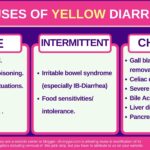7 Causes of Bright (Lime) Green Stool & When to Worry
Our content is not intended nor recommended as a substitute for medical advice by your doctor. Use for informational purposes only.
What you need to know:
- The stool acquires its brown color from processing the green bile inside the digestive tract to a brown pigment called (Stercobilin).
- When bile passes too quickly (due to diarrhea) through the digestive tract, it will not have enough time to turn brown. This causes light or lime-green stool in severe cases of diarrhea.
- Also, green foods and green food colorings may cause the greenish color of the stool.
- The stool of a newborn in his first few days of life usually is bright or dark green (called the meconium).
Legal notice:
This article is written and published by www.oh-mygut.com. Republishing this content without written permission from the owner is considered content theft. Copyrights Reserved.
1. Acute viral gastroenteritis (stomach flu).
When you experience bright (lime) green poop with an attack of diarrhea, diarrhea is probably the cause of such poop color.
Most of the attacks of acute diarrhea are often due to viral gastroenteritis (stomach flu). Up to 70% of the cases of acute gastroenteritis are due to viruses such as:
- Norovirus.
- Rotavirus.
- Adenoviruses.
- And others, including COVID-19 diarrhea. We discussed the possibility of the green stool as a sign of COVID here.
Most of the cases of acute diarrhea are often light brown or yellow. However, dark green or bright (lime) green can also occur.
How does stool turn lime green with severe diarrhea?
Bile (bilirubin) is a greenish substance secreted from your liver into the digestive tract (the small intestine and the colon).
Under normal conditions, bacteria that usually live inside your digestive tract will convert the green bilirubin into a brownish substance called (stercobilin), giving the stool its standard brown color.
With severe diarrhea, the rapid passage of contents of the gut tract will not allow enough time for the bile to turn brown.
Severe diarrhea often manifests with yellow watery diarrhea. In addition, patients with severe diarrhea may pass bright or lime-green bile in their stool.
Symptoms of stomach flu:
- Light brown to bright yellow watery diarrhea at first. As diarrhea continues, the poop may turn bright or lime green (bile poop).
- Abdominal cramps and pain.
- Nausea with or without vomiting.
- Loss of appetite (anorexia).
- Fever, usually low grade.
- Maybe muscle aches or headache
- It lasts for hours to a few days.
- NOT associated with bloody stools or high-grade fever.
- Complications commonly occur in young children or older ages. It includes dehydration, nutritional imbalances, and weakness.
2. Other types of gastroenteritis and food poisoning.
Any condition that leads to severe diarrhea will lead to bright green poop due to the passage of unchanged bile with diarrhea.
The causes of acute diarrhea are almost always due to infection and food-borne illnesses (food poisoning).
Bacterial diarrhea is also common. However, bacterial gastroenteritis is often more severe, causing high-grade fever, severe diarrhea, and maybe blood and mucus in the stool (dysentery).
The table below summarizes the common causes of acute gastroenteritis (reference):
| Viral: 50%–70% | Bacterial: 15%–20% | Parasitic: 10%–15% |
|---|---|---|
| Norovirus | Shigella | Giardia |
| Rotavirus | Salmonella | Amebiasis |
| Enteric adenovirus types 40 and 41 | Campylobacter | Cryptosporidium |
| Astrovirus | E Coli | Isospora |
| Coronavirus | Vibrio | Cyclospora |
| Some picornaviruses | Yersinia | Microsporidium |
| C difficile |
3. Bright green stool in newborns and infants.
The stool of newborns (in the first 48 to 72 of their life) is called the meconium. It is not brown, but rather green.
Often the meconium of the newborn baby is dark or olive green. However, all shades of green, including bright or lime green, are considered normal in a newborn.
The meconium can also be yellow or brown. The passage of meconium in the first 24 to 48 hours of the baby’s life is an important indicator of good digestive function (reference).
Moreover, infants and babies (under one year old) can usually be green. The greenish poop of infants is present because they only consume breastmilk or formula.
However, bright green poop in a baby can be a sign of diarrhea. So, you must differentiate between healthy green poop and diarrhea-related green poop.
Green poop can be a sign of diarrhea in a baby when there are:
- Too frequent bowel motions of the baby than usual.
- Very loose or watery consistency of the poop.
- Presence of other signs of gastroenteritis, such as frequent vomiting or crying.
- Fever.
- The abnormally offensive odor of the poop.
- Signs of dehydration include the absence of a wet diaper for 3 hours or more, dry eyes during crying, dry lips, or sunken eyes.
4. Too much green leafy vegetables in food.
Green leafy vegetables contain a green substance called Chlorophyll. Therefore, eating too many green leafy vegetables can lead to dark or even bright green poop.
The poop color change is directly proportional to the amount you eat.
Causes include:
- Spinach
- Kale
- Cabbage.
- Beet greens
- Romaine Lettuce.
- Blueberries.
5. Other green foods and food coloring.
Green dyes can also lead to bright green poop when consumed excessively.
They cause symptomless dark green poop with no other digestive issues like green vegetables.
Examples:
- Dyes or color additives used in AIcohoIic drinks.
- Green-colored ice pops.
- Green-colored sodas and soft drinks.
- Drink mixes.
- Natural dyes, such as green grapes, cucumber, etc.
6. The recent removal of the gallbladder (post-cholecystectomy diarrhea).
The gallbladder’s primary function is to store bile and excrete it into the small intestine when needed (after meals).
Severe diarrhea may occur when the gallbladder is removed (often due to gallstones or acute cholecystitis).
The diarrhea is often due to loss of the storage function of the gallbladder, leading to excess bile in the intestine.
One in every five persons undergoing cholecystectomy suffers from postcholecystectomy diarrhea.
Postcholecystectomy diarrhea is often due to bile acid malabsorption (secondary to increased bile acid secretion to the digestive tract).
Typically, diarrhea resolves within weeks to a few months after gallbladder removal. However, Some may continue to suffer for years.
Bright green poop from postcholecystectomy diarrhea may respond to bile acid binders such as cholestyramine (Questran®). Consult your doctor if your dark green poop is linked to previous gallbladder surgery.
7. Chronic digestive conditions that lead to diarrhea.
Diarrhea that lasts for persists more than four weeks are called chronic diarrhea.
Severe forms of chronic diarrhea lead to bright or lime-green poop. Milder cases of chronic diarrhea are often light-brown or yellowish. The green color is often a sign of severity.
Common causes include:
- Chronic digestive system infections such as recurrent Clostridioides difficile infection.
- Severe forms of diarrhea-predominant irritable bowel syndrome.
- Celiac disease.
- Inflammatory bowel diseases (Crohn’s disease, ulcerative colitis, and microscopic colitis).
- Food intolerances (particularly lactose intolerance).
- Small intestinal bacterial overgrowth (SIBO).
- Chronic pancreatitis.
- Hyperthyroidism.
- Colorectal cancer or neuroendocrine tumors such as carcinoid and VIPoma.
- Diabetes-related diarrhea.
- Cystic fibrosis.
- And others.
When to worry about bright green poop?
See a doctor if:
- Bright green poop is associated with severe diarrhea (especially in babies).
- Prolonged bright or lime green poop periods for more than days without apparent cause.
- Abdominal pain.
- Nausea or vomiting.
- Sings of dehydration include extreme thirst, peeing little urine, dark urine, confusion, or coma.
- Fever.
- Presence of blood in the stool.
- Evidence-based
- Written by a doctor.

Related Posts:
- Blood On The Outside Of The Stool: 7 Causes & When To Worry.
- 7 Causes Of Blood In Stool With IBS & When To Worry.
- Large Black Spots In Stool: Common Causes & When To Worry
- Bright Yellow Watery Diarrhea: 6 Causes Simplified…
- Black Watery Diarrhea: 5 Causes & When To Worry.
- When to worry about ALT levels? Gastroenterologist Explains.






